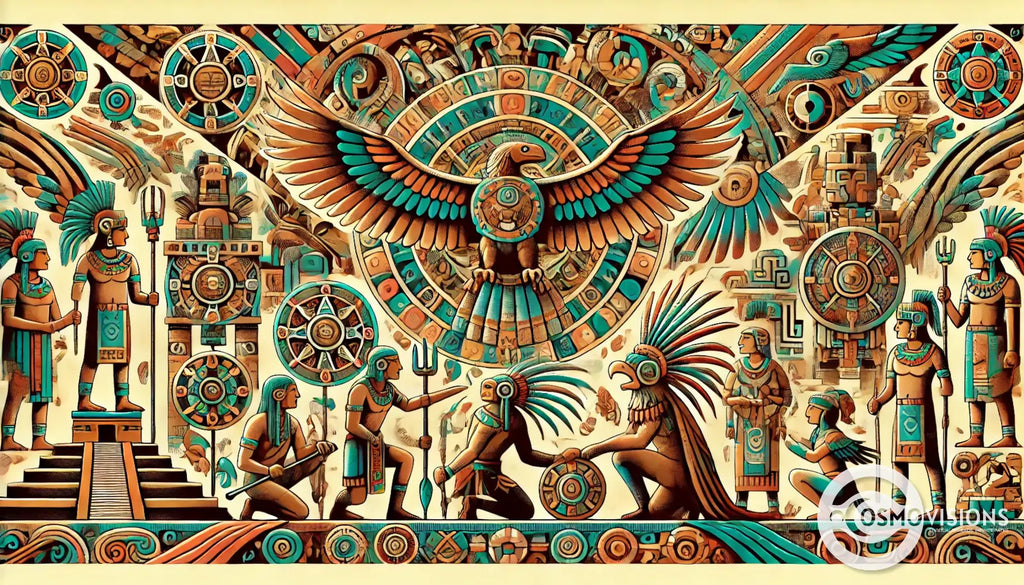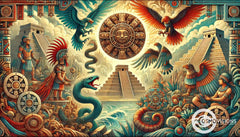The Mystical Realm of Flower Prince Xochipilli: Aztec God of Love and Fertility
Posted by Massimiliano Geraci

Are you curious about ancient gods and their stories? Maybe you’ve heard about Greek or Roman gods, but there’s a whole world of other mythologies out there. One interesting figure is Xochipilli, the Aztec god known for love and fertility within the Aztec Empire.
He was also the god of art, games, flowers, and music. This shows us how people long ago saw the importance of these things in their lives.
This blog post will explore who Xochipilli was and why he was so important to the Aztecs. We’ll look at his symbols, his role in their culture, and even some intriguing facts like his connection to certain plants that cause visions.
By learning about Xochipilli, you can understand more about values that were dear to the Aztecs — such as artistry, joyfulness in life’s pleasures, and respect for nature’s power through fertility.
Ready to find out more? Keep reading!
Key Takeaways
1. Xochipilli is the Aztec god known for love, fertility, art, games, flowers, and music. His name means "flower prince," showing his deep connection to nature's beauty.
2. The statue of Xochipilli was found in the mid-19th century near Tlalmanalco and now lives in the Museo Nacional de Antropología in Mexico City. It shows signs linking him to sacred plants and mushrooms, suggesting ancient rituals.
3. Symbols important to Xochipilli include feathers, flowers on his headdress, a necklace made of shells and jade, and decorations with butterflies. These symbols represent joy, transformation, love for nature.
4. In Aztec culture, festivals honoring Xochipilli involved drinking pulque and offering corn at altars as a way to celebrate life’s renewal and connect with natural cycles.
5. Xochipilli's family in the Aztec pantheon includes gods responsible for beauty (Xochiquetzal), health (Ixtlilton), fun (Macuilxóchitl), showing how different forces come together to create harmony.
Xochipilli: The Flower Prince
Aztec god Xochipilli is a vivid figure in Aztec mythology. He embodies the essence of art, games, dance, flowers, and song. His name means “flower prince,” echoing his deep connection to the beauty and joy found in nature’s blooms.
This deity wears a relaxed expression, often depicted holding a bouquet of flowers—a symbol of his carefree spirit and love for all things beautiful. Xochipilli shares ties with the maize deity Centéotl, earning him another title: the ‘Corn-flower Prince’ or Centéotl-Xochipilli.
As the 7th Lord of the Day, he oversees creativity and leisure activities like writing, painting, and patolli—a favored game among his followers. The term 'seven flower' signifies his patronage of artistic endeavors, particularly in the realms of writing and painting. Xochipilli brings light into our lives through artistry and nature’s splendor.
Celebrated not just as a patron but also an inspiration for artists and thinkers alike across Mexico City—where representations grace places such as museums—Xochipilli remains relevant today.
Viewers can find statues dedicated to him at locations including the National Museum of Anthropology (Museo Nacional de Antropología). These artworks capture his spirit perfectly: cross-legged with dilated pupils suggesting realms beyond mere sight—perhaps hinting at his association with sacred mushrooms known for their mind-altering properties.
Through these images carved from stone hundreds of years ago shines Xochipilli’s enduring legacy—as vibrant now as it was in ancient times.
Symbols and Attributes of Xochipilli
Xochipilli stands out with his headdress full of feathers and flowers. He also wears an oyohualli talisman around his neck and a necklace of shells and jade. These items show his deep connection to nature and beauty, marking him as the cheerful deity of love, art, games, beauty, dance, flowers, maize, and song in Aztec belief.
He is often depicted wearing a teardrop-shaped pendant fashioned from mother-of-pearl, symbolizing his association with pleasure and euphoria.
His image often features decorations with many flowers and butterflies; these symbols express joy and life’s fleeting nature.
Butterflies flutter around him as a sign of transformation and the soul’s journey. He is also linked to poetry, which was highly prized in Aztec culture for its spiritual power. His association with Ozomatli (Monkey) Day reflects his playful side.
He invites us to enjoy life’s pleasures while remembering our spiritual quests.
His symbols tell us more than just historical beliefs; they invite us into a world where joy harmonizes with sacred duties—a place where we can explore connections between Earth’s beauty and human creativity.
This understanding guides us towards appreciating Xochipilli’s role within Aztec society next.
The Role of Xochipilli in Aztec Culture
Xochipilli held a special place in the heart of Aztec society. People saw him as the god of flowers, love, and fertility. They believed he brought joy and oversaw the growth of plants. He was also associated with musical instruments, emphasizing his role in arts and revelry.
During festivals in his honor, like those in Tecuilhuitontli, his followers drank plenty of pulque to celebrate life and renewal. These gatherings weren’t just parties but sacred moments connecting with nature’s cycles. The term 'five flower' highlights Xochipilli's playful nature and association with games and festivities.
In places like Xochimilco, worshippers offered corn and pulque at altars dedicated to him. This showed their respect and asked for his blessings on their crops. Xochipilli’s influence went beyond agriculture; he symbolized acceptance within LGBTQ+ communities and guarded over nature’s riches for environmentalists.
His role was vital: linking people to each other and the Earth through rituals that marked the passing seasons and life’s beauty.

Significance of the Xochipilli Statue
The Xochipilli statue, discovered in the mid-19th century near Tlalmanalco on the side of Popocatépetl volcano, is a key artifact. It dates back to the 15th century and now sits in the Museo Nacional de Antropología’s Aztec hall in Mexico City.
The statue is often compared to similar artifacts, such as those found in the Aztec terracotta Lombards Museum, which also highlight the history and depiction of Xochipilli.
This piece shows dilated pupils which suggest the effect of hallucinogenic mushrooms. Experts say this represents a figure experiencing entheogenic ecstasy. The Xochipilli statue bridges our understanding between ancient spirituality and ritualistic practices. This finding gives us deep insight into Aztec culture, especially their use of psychotropic plants for spiritual and ceremonial purposes. The detailed carving adds to our knowledge about the religious life and artistic expression of an advanced civilization that revere nature, gods, and cosmic harmony alike.
The Aztec Calendar and its Connection to Xochipilli
Xochipilli, the Aztec god of love and fertility, is a special figure in the Aztec calendar. This system marks time with days and months that are closely linked to gods and their domains.
Xochipilli's connection shines on the 11th day, named Ozomatli (Monkey). This day celebrates joy, creativity, and music—traits that define him.
During Tecuilhuitontli, the eighth month in this calendar, people held grand festivals in his honor. These celebrations were times of excess and mischief, reflecting Xochipilli's role as one of the Ahuiateteo - gods who oversee indulgence.
His brother Macuilxochitl also plays here; both shared responsibilities for games and merrymaking during these periods.
Supplementary Insights on Xochipilli
For those eager to dive deeper, “Supplementary Insights on Xochipilli” offer a unique window into the colorful tapestry of Xochipilli’s world. Explore the mysteries that tie him to mind-altering herbs and uncover the questions many have about this fascinating deity.
Refer to the World History Encyclopedia for further reading on Aztec deities and cultural aspects.
Entheogen Connection
Xochipilli, the Aztec god of flowers, had a deep connection with entheogens. His statue is covered in carvings of holy plants and mushrooms. These are not just any plants; they can change how people see the world.
The figure shows Xochipilli with wide eyes like someone who has eaten these special mushrooms. He looks happy, singing and shaking rattles.
Laurette Séjourné shared insights about this flower’s spiritual link to the sun. This bond reminds us that Xochipilli was not only about beauty but also about deeper visions and understandings, brought on by sacred plants.
Certain practices, including the use of entheogens, continued from pre-Columbian times into colonial Mexico.
Next up, let’s look into some frequently asked questions about Xochipilli.
Related Deities in the Aztec Pantheon
Xochipilli shares his magical world with a family of powerful beings. His sister, Xochiquetzal, shines as the goddess of beauty and love. Together, they fill the Aztec universe with joy and color.
Ixtlilton, one of his brothers, takes care of health and leads dances that heal the body and spirit. The other brother, Macuilxóchitl, brings fun through games and laughter. This family shows how different forces come together to create harmony in life.
The sun lights their way with Tonatiuh guiding them from high above. Piltzintecuhtli reveals himself as a kind version of this bright god when he becomes young again every morning.
The Ahuiateteo gods join them, too—they love everything excessively but remind everyone to enjoy life wisely. Each deity adds its unique spark to the Aztec pantheon, supporting each other like stars in a vast sky.

Conclusion
The mystical world of Xochipilli opens a door to understanding ancient Aztec life and beliefs. With his ties to art, joy, and nature's cycles, this deity shows how the Aztecs celebrated life's pleasures.
The flower prince's statue in Mexico City offers a tangible link to this past world. His symbols and tales continue to inspire those who study Mesoamerican cultures today. As we explore these ancient stories, we connect with human emotions that span across time.
Explore our comprehensive guide on the Aztec calendar to learn more about the celestial cycles that governed Xochipilli's festivals and rituals.
FAQs
1. Who is Xochipilli in Aztec beliefs?
Xochipilli is the Aztec god of love, art, games, beauty, dance, flowers, maize, and fertility. He brings joy and oversees all things pleasant.
2. What does "Xochipilli" mean?
His name comes from the Nahuatl words for flower ("xōchitl") and prince ("pilli"), making him the "Flower Prince". This title reflects his role in promoting growth and happiness.
3. Can you tell me about a famous statue of Xochipilli?
Yes! A well-known sculpture of Xochipilli can be seen at the Museum of Anthropology in Mexico City. It shows him seated with a joyful expression, surrounded by carvings of sacred plants.
Did Xochipilli have any psychotropic plants he was associated with?
Indeed! Xochipilli was linked to several hallucinogenic plants like maguey and tobacco which were used in religious ceremonies to connect with the divine.
5. Was there anyone else paired with Xochipilli?
Xochiquetzal was often paired with him as his female counterpart or twin sister. She too governed over areas related to fertility and beauty from a feminine perspective.
6. How did people honor Xochipilli during their festivals?
During festivities dedicated to him, people engaged in music-making using drums and flutes; they danced; created art; adorned themselves brightly; participated in ceremonial use of psychedelic substances; played games that celebrated life’s pleasures—all reflecting aspects that pleased this deity.
Relevant books on Aztec deities and cultural practices, such as Randy P. Conner's 'Blossom of Bone' and 'Cassell's Encyclopedia of Queer Myth, Symbol and Spirit' by Conner, Sparks, and Sparks, were published in San Francisco.






















